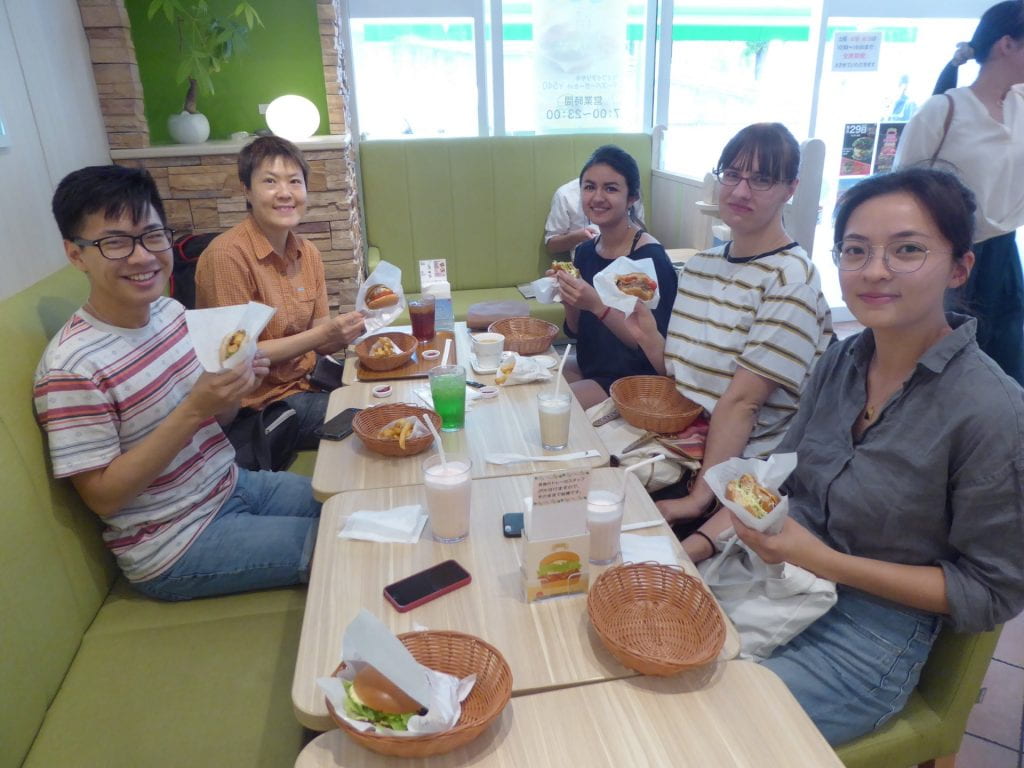The EnviroLab Asia Clinic Trip took place in Japan from May 20 to June 1, 2019. In this blog post, Bailey Lai (environmental analysis, PO’ 19) reflects on the first day of activities. Before the Clinic Trip, students took a class that introduced them to environmental issues of the region. Students also focused on specific research topics by working in lab groups. Bailey’s lab, led by Professor Angelina Chin (history, PO), studied issues of access for the elderly and disabled in Japan. The lab met several times in the spring semester to prepare for the Trip.

Accessibility Lab members take a lunch break (left to right: Bailey Lai, Angelina Chin, Meena Venkatraman, Alida Schefers, Yufei Guo).
22 May 2019
by Bailey Lai (environmental analysis, PO’ 19)
Today was packed full of first-time events. After flying in last night, I awoke in my hotel room to the sun shining through the window. Had I overslept on my first morning of EnviroLab Clinic Trip? No, it turns out: Japan has no daylight savings time, so the sun had risen by 5 AM and woken me up. On top of this, I was still jetlagged from 12 hours of flying and moving 16 hours ahead of the American West Coast. Unable to fall back asleep, I arose from bed and decided on an early start to our first full day. After a hearty breakfast and a welcome presentation with the local hosting staff, we sat in a bus headed towards the iconic Osaka Castle. Visiting this historic castle first thing in our Clinic Trip grounded me in the reality that we are finally in this country we have learned about for the past semester.
After getting a panoramic view of the city atop Osaka Castle, we took our bus to the ATC Ageless Center. Visiting the ATC Ageless Center helped complement our study of barrier-free universal design. Our class got to exhibit different ways in which rooms can be retrofitted with assistive technology and designed with accessibility in mind. We got to ride on wheelchairs through an obstacle course of daily barriers with doors, small ledges, tight corners, and bumpy footpaths. The attendants even let us test a motorized electric wheelchair, which provide a boost going up a slope and automatically brake going down a slope. However, one thing that fellow lab mate Alida and I noted was that a lot of the most advanced assistive technology cost a lot. For example, the wheelchair with two extra sets of wheels to climb stairs looked helpful for homes with staircases, but its cost of over one million yen (approximately $10,000 USD) would make it economically inaccessible to most households.
Touring the environmental products showroom also presented novel ideas. In Japan, many companies hoping to reduce their waste rely on each other’s different expertise to create new systems of sustainability. For example, the green tea company Itoen produces over 50,000 tons of tea leaf waste annually, so they asked over 150 outside companies to design products to recycle and reuse this byproduct. This led to creative results like paper envelopes and plastic containers made partly from used tea leaves. From this presentation, we learned the importance of many companies collaborating to find opportunities for reuse, repurpose, and reselling of what we usually consider “waste”.
Later in the afternoon, we toured the barrier-free guest rooms in the Big-I International Communication Center for Persons with Disabilities, the hotel we are staying at. Looking at the guest rooms gave us a better sense of how barrier-free design has been implemented in real life. However, the hotel employee guiding us also share that funding was a concern. The government originally paid to build and run Big-I as the country’s first showcase of barrier-free accessible design, but after budget cuts a non-profit now runs the center. As funds from NGOs are much more limited, the Big-I has not been updated much since its opening in 2001, as maintaining and upkeeping the existing equipment and building uses most of the budget. Our group visited a lot of informative exhibits related to our lab today, and I cannot wait to see what will be coming next.
